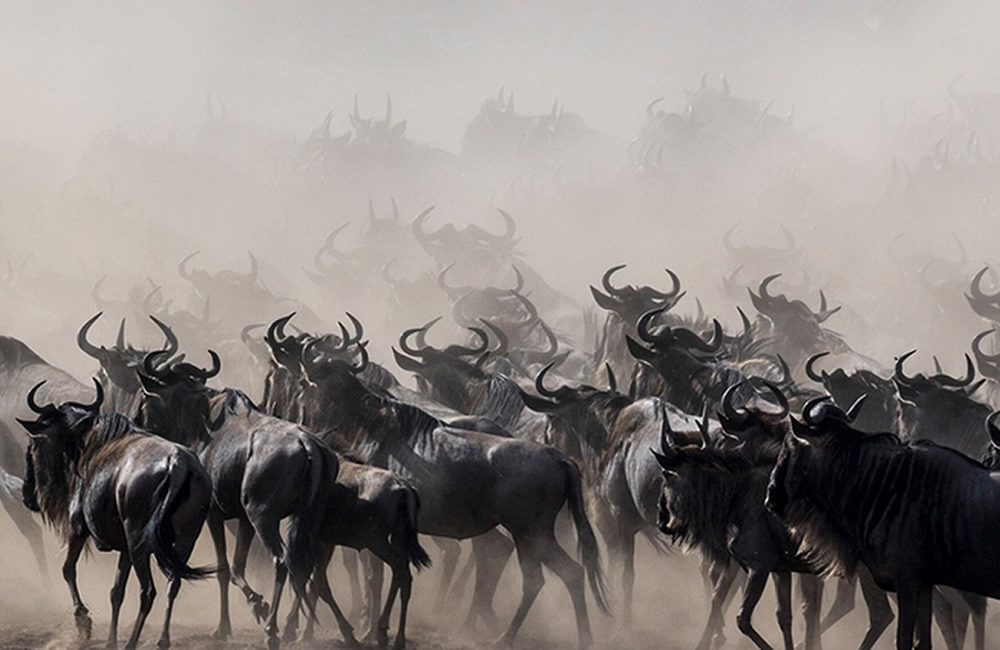The Great Wildebeest Migration is one of the most breathtaking wildlife spectacles on Earth. Every year, over 1.5 million wildebeest, along with zebras and gazelles, embark on a perilous journey across the vast plains of Tanzania and Kenya in search of fresh grazing lands. This awe-inspiring natural event is filled with drama, danger, and survival, making it a must-see for safari enthusiasts and nature lovers alike.
This blog will guide you through the fascinating details of the migration, the best places and times to witness it, and tips for an unforgettable safari experience.
- Understanding the Wildebeest Migration: Nature’s Greatest Show
The Great Migration is a continuous, year-round cycle that follows the seasonal rains and the availability of fresh grass. Though many people imagine it as a single event, it is actually an ongoing movement across the Serengeti-Mara ecosystem.
The Migration Cycle: Month-by-Month Breakdown
January to March: The calving season takes place in the southern Serengeti and Ndutu region of Tanzania. Over 500,000 wildebeest calves are born within a few weeks, attracting predators like lions, cheetahs, and hyenas.
April to June: The herds start moving northward as the dry season sets in, crossing the central and western Serengeti.
July to October: The migration reaches its most dramatic phase—the famous Mara River crossing. Thousands of wildebeest risk their lives as they plunge into crocodile-infested waters to reach the Masai Mara in Kenya.
November to December: The herds start their journey back to Tanzania as the short rains bring new grazing lands in the Serengeti.
- Best Places to Witness the Wildebeest Migration
Serengeti National Park, Tanzania
Serengeti National Park is the heart of the migration, covering vast landscapes where you can witness different phases of the journey. From calving season in the south to the thrilling Grumeti River crossing in the west, the Serengeti offers unmatched opportunities to observe the migration up close.
Best time to visit: December to July (depending on which part of the migration you want to see)
Masai Mara National Reserve, Kenya
The Masai Mara is renowned for hosting the most dramatic part of the migration—the Mara River crossing. Watching thousands of wildebeest and zebras navigate the strong currents while avoiding hungry crocodiles is an unforgettable experience.
Best time to visit: July to October
Ngorongoro Conservation Area, Tanzania
Though not as famous for the migration itself, the Ngorongoro area provides an excellent backdrop for viewing wildebeest in the early months of the year during the calving season. It is also home to a rich variety of predators.
Best time to visit: January to March
- Planning Your Wildebeest Migration Safari: Essential Tips
Choosing the Right Time and Location
To experience the migration in all its glory, plan your trip based on the phase you want to witness. Whether it’s the birth of new life in Ndutu, the dangerous Grumeti or Mara River crossings, or the vast herds roaming the Serengeti plains, timing is everything.
Booking a Safari Tour
Opting for a guided safari enhances your experience, as expert guides know where to find the herds and how to position you for the best viewing. Consider a mobile safari camp that moves with the migration for a front-row seat to nature’s greatest show.
What to Pack for Your Safari
- Neutral-colored, lightweight, and breathable outfits
- A good camera with a zoom lens, binoculars, and a safari hat
- Insect repellent, sunscreen, and comfortable walking shoes
Why the Great Migration is a Must-See
The Great Wildebeest Migration is more than just an annual event—it’s a testament to the power of nature and the resilience of wildlife. Whether you choose to witness the birthing season in Tanzania or the heart-pounding river crossings in Kenya, this journey through Africa’s wild heart is guaranteed to leave you in awe.
